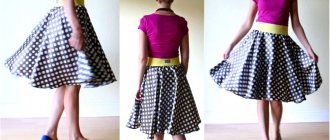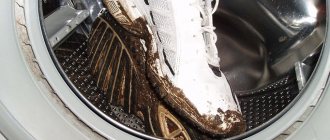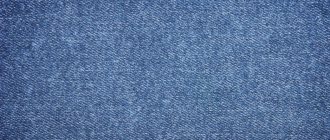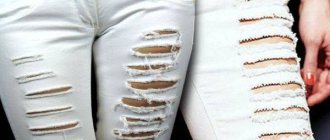Often you don’t want to part with beautiful and original jeans, despite the fact that holes have appeared at the knees and frayed areas of denim have appeared between the legs. There are some clothes in which you feel very comfortable and comfortable, despite its age. And jeans, whether men's or women's, are just such clothing. But often, it is on jeans that scuffs and even holes form, and you have to think about how to put patches on jeans.
How to sew up holes in jeans or repair frayed areas so that they are completely invisible? You can have your jeans repaired at a workshop, but often such repairs will cost more than buying new jeans. You can install the patches yourself if you have a sewing machine. But where can you get denim fabric for a patch? To darn a hole in jeans with thread, but how to darn correctly? We’ll try to answer all these questions about how to fix holes and repair old jeans with our own hands.
How to mend a hole in jeans using the stitching method.
How to make a patch between your legs
You can solve the problem of jeans frayed between your legs with patches. This method requires having any denim material on hand. It is better to use the same material that remains after shortening the jeans or a spare piece that comes with the pants.
A pocket torn at the seam can be repaired discreetly
How to sew a patch on jeans between the legs? In general, the following actions are performed:
- Searching for suitable fabric by color, shade and texture, if there is no original one;
- Laying out your pants so that the hole is clearly visible;
- Cutting off the required piece of fabric and stitching it on a machine;
- Turn the jeans inside out and apply the patch facing inside out;
- Sew a patch along the contour;
- Turn the pants inside out and sew them right side together.
A beautiful applique can save a thing
. Important! To repair jeans in intimate areas, you can also use ready-made applications and patches. They do not need edge processing and have various shapes and contain drawings.
Some models already contain drawings
Jeans repair (thing)
Often people get used to their favorite, comfortable things and do not want to part with them.
Over time, clothing wears out and becomes unusable. Today I will tell you how to “extend the life” of ordinary jeans and show you how to beautifully mend frayed and torn areas. The best way to restore jeans is with a gizmo. Essentially, quilting is the restoration of fabric using stitches from a sewing machine. I have a great sample of jeans with different rips and for me this is an opportunity to show different versions of the piece on one trouser, which will be in different places.
First, I select the appropriate fabric for the patches that will be attached to the wrong side of the jeans. For light and thin jeans, you can use light or dark dublerin (this is a fabric-based adhesive) of medium-thin density. For warm and thick jeans, I usually choose denim patches. When choosing a color, you can use the wrong side.
So I have:
- Two identical wear marks located at the bottom of the rear patch pockets.
- There is a tear on the side of the back patch pocket.
- A very common fray in jeans is between the legs.
In total I have 4 places on which I will sew invisible patches using the stitching method.
For cases 1 and 2, from the selected pieces I cut out circles slightly larger than the rubs themselves. On the back halves of the trousers, I use the patches on the wrong side and finish the edges with an overlocker.
For option 3 - I use the front side of the denim patches and cut out one patch that covers two tears between the legs and also process it with an overlocker.
On the back halves I rip open the patch pockets in the right places. My thing will be placed under the pockets.
Then you need to attach the patches to the inside of the jeans. For this I use paper-based adhesive web. Using an iron, I glue it to the desired side of the patches, and then to the trousers, respectively. Here you need to not confuse which patches were selected and which side. To glue patches, you can use cobwebs without a paper backing.
How invisible our patch will be mainly depends on well-chosen thread colors . As you know, jeans are often of uneven color - in some places they are darker or lighter, so we select threads for a specific place.
1 option (left pocket at the bottom and a gap on the side of the right pocket)
For piecing, I set the stitch size to small. The jeans that I initially repair (for decoration) had abrasions made by the manufacturer, so I do a loose piece on the back halves using zigzag machine stitches along the inclination of the hem of the fabric, thereby preserving the design of the trousers.
Option 2 (right pocket, bottom)
For comparison, on the right pocket, I make a loose piece with vertical zigzags (I place the machine stitches vertically, not along the hem of the fabric). In my opinion, this option is less noticeable. Very often I use this thing on the knees of jeans (if the gap is not vertical).
Options 1 and 2 of the piece are called light, since the gap is not stitched solid. The patch fixes the tear or fraying and protects it from further tears, but remains visible for decorating the trousers.
Option 3 of the piece (between the legs) – dense. Here the machine stitches are superimposed very close to each other. This method is used for strength and to seal the gap. In my case, I sew up existing holes with thick stitches, and with a light stitch I go through thin places where there are no holes yet, but will soon be worn out.
General recommendations for darning jeans:
- In dense (thick) pieces, make machine stitches perpendicular to the gap (across) - this will be more reliable.
- So that the thing is not too rough and hard on the jeans. We apply stitches tightly only on obvious holes, capturing entire edges. Where they are not there - only a light thing, denser or less dense - here it is at your discretion. The inclination of the lines is the same as that of a dense piece.
- After washing, the glued patches will come off, so I initially make sure that they are secured with stitches. Sometimes at this moment, as needed, I add threads of a different desired color. On the inside it looks like this:
We select the color of the threads and sew the back pockets. The photo of the finished item was not very good, but it shows the mended areas under the pockets. On the right half, under the patch pocket, the repair is almost invisible (photo 1 at the very top of the article).
Darning is a common repair on jeans. The more you do it, the more experience you will gain and the better it will turn out. Good luck!
How to mend jeans between the legs using a machine
Holes between the legs are one of the most common problems with pants. It is in these places that the maximum friction of the trouser legs occurs, which is the main reason for the appearance of tears. As you already know: you can darn using a machine or by hand. The manual option has already been considered, so it is worth examining in detail the process of darning with a machine.
Invisible stitching
To do this you need:
- Set the “Straight stitch” mode on the machine;
- Next, the fabric should be compacted by tightly pressing the edges of the material to each other and making parallel lines using a foot;
- Steam the darning area so that it becomes almost invisible to the human eye.
Darning foot
Large holes cannot be sewn up this way, but if the fabric has just begun to unravel, this will help it maintain its appearance and gain additional density in this place.
You might be interested in this: The procedure for sewing a tulle skirt with your own hands
Application on the knee
Instructions for proper stitching
If a person has never darned holes in his pants, then it would be ideal to read the instructions on this matter. One of them will be presented below. Having completed all these points, you can easily learn how to sew up a hole in your pants unnoticed. Actually instructions:
- Choose threads whose color should be invisible against the background color of the fabric. You should also choose the right and thick needle. Thin and small needles are not suitable for denim;
- Thread a thread through a needle and tie a knot at its end, or better yet several knots in one place;
- Sew the hole from the wrong side, tightening the thread as tightly as possible. You need to sew close to the edge of the seams of the holes;
- During the darning process, you should constantly look at the front side of the fabric so that the seam is smooth and beautiful;
- Make a few additional knots so that the seam does not come undone when worn, and cut off the rest of the thread.
We sew by hand
If the hole turns out to be a straight or angular cut, then you can simply and efficiently darn on a sewing machine, for example, the popular Janome. To start the process, you need to choose the color and shade of thread that is suitable for darning jeans. Next, you need to make several stitches, which should be the same in size, as well as the tension of the individual threads. If these rules are not followed, the torn hole will look worse than before repair. It turns out that sewing up a hole in jeans without being noticed is quite simple.
Torn knees with torn edges
Important! If we are talking about repairing children's or women's clothes, then you can apply appliqués, patches on top, or decorate the repair as an element of clothing design.
How to sew without a machine
The easiest way to sew up any type of hole in jeans without using a sewing machine is to simply darn or apply a patch. You can create decor around and on the hole not only with the help of various denim and non-denim fabrics and buttons, but also with other accessories and ribbon. It is better not to repair children's and thin pants in this way, since the hole may tear even more, but use hand sewing on a piece of other denim. In general, the same instructions described above will work for mending a hole.
Hand stitching technique
Choosing needles and thread to sew up a hole in jeans
If you plan to sew by hand, take care to choose a needle that is the right size for the material. All needles are divided into industrial and household. We choose from the second category, since we are not interested in industrial ones. Each package has symbols that indicate what material the needles are intended for in terms of structure and thickness. For jeans, numbers 11(75) or 14(90) are suitable.
And in order to insert the thread freely, its size must also match the needle number. The threads should not be too thin so that the hole between the legs, which we have to sew up, does not come apart again due to their breaking. The best option is cotton No. 50-80 or synthetic No. 50-60.
Prepare the tools and materials necessary for work
- How to sew up a hole in jeans between the legs: repairing pants at home
Elimination of defects on the knees
No matter how hard the craftswoman tries to hide the patch on her knee, it will be enough to walk in these clothes on a bright spring day, and the traces of the repairs will immediately catch the eye.
That's why it's better to switch your attention from careful camouflage to a small design experiment. A tasteful silhouette and appropriate coloring of the patch will allow you to achieve an effect comparable to that produced by the best handmade patches from famous fashion designers and designers.
To solve this problem, you will need a piece of denim fabric that matches the material of the jeans in the spectral region, but is different in shade. It's easy to guess that deep blue denim patches will look good on ultramarine jeans.
In order not to waste money on material, in this case you can get by by cutting a piece from an unnecessary denim jacket.
A master class on how to properly apply knee patches is as follows:
- First, you should calculate the size of the patch and cut it beautifully from the workpiece.
- It is advisable that the patch is no narrower than the trouser leg. It should reach 10 cm in length. The margin for hem is half a centimeter.
- Next, the patch is folded and basted.
- It is then attached to the trouser leg using a sewing machine.
- In order for the aesthetic effect to be complete, a second similar insert is usually made on the other leg. In this case, you can use the right and left versions of the figures: scallop shells, starfish, galloping mustangs.
Tools for work
To sew up a hole in jeans between the legs or anywhere else, you need to prepare several tools and materials. To work you will need:
- strong threads;
- a piece of chalk;
- pen, piece of paper;
- iron equipped with a steam generator;
- durable needle;
- scissors;
- a piece of soft material (if a patch will be sewn on).
If there is denim of the same color as the damaged item, it is better to take it. It is also advisable to select threads of the same color, otherwise the sewn area will stand out against the background of the rest of the fabric.
How to patch a cut or hole with straight edges by hand
- choose threads of the desired shade;
- fold the edges end-to-end and make the required number of parallel stitches, basting the edges;
- having reached the edge, make one vertical stitch down and lay another path of parallel stitches in the opposite direction;
- thus, a basis for weaving is obtained. When it is finished, the needle and thread are passed through parallel stitches one at a time, the result is a weave like that of native fabric;
- You need to make several such rows, stitching the rows of threads as close to each other as possible;
- after completing the required number of vertical and horizontal rows, the darning will close the hole, and if the threads are chosen correctly, then no traces of repair will be visible.
Professional darning of jeans
Sometimes your favorite jeans get torn in the most unexpected places. I especially feel sorry for expensive branded jeans, which, it would seem, will not be demolished... And you won’t even raise your hand to throw them away, and you can no longer wear them like that. Sad pictures with awkward patches - wedges from grandmother's times - come into my head... Plans to alter my son's jeans, take him to the country... and yet it's a pity... Fortunately, everything can be fixed if you have any sewing machine and you have minimal skills to work on her.
One of the conditions for success is to choose the right threads. Threads are suitable for regular polyester No. 40. The choice in sewing accessories stores is very large. For example, “Ideal” or “Dor tak”. We'll select it like this. Let's choose a suitable color, wind a little bit of thread on your finger, and apply this “winding” to the fabric. The two colors should be almost the same, then the darning will be almost invisible.
We will also need adhesive fabric. It is sold in fabric stores and is quite inexpensive. Comes in white and black. Now turn the jeans inside out. We cut out pieces of adhesive fabric and apply them to the places where we will do the darning.
We glue our blanks. This will make the darning process easier. The iron must be hot enough. The side with glue is rougher to the touch. Place the patch with the adhesive side on the jeans and slowly iron the pieces, pressing them well. Wait a minute, let it cool and set well.
Darning can be done on any household machine using reverse (reverse motion); even the oldest sewing machines have this function. Set the stitch length regulator to 2.8 -3.0 mm.
We darn slowly at first. Let’s “block” the impulse with a wide zigzag, similar to a cardiogram, moving the line forward and backward. The edges of our “cardiogram” should not be smooth, then the darning will be less noticeable and more natural.
Now we darn very carefully the place of the gust itself and the neighboring areas. If it is inconvenient to darn with large lines, work with small sections, connecting them with smooth transitions. If white threads are knocked out between the lines, point the needle directly at them until they are noticeable. By the way, if the gust is large and there are a lot of threads sticking out, you can trim off the excess, but do not cut off all the threads until there is a complete hole; it is better to leave the base. Although restoration is possible even with the complete absence of threads, it is a little more difficult.
IMPORTANT: the darning will look more natural if you sew in the direction of the pattern, and not in the direction of the hem of the fabric!
Sew carefully, in parallel, without rushing. The result will please you. The skill will gradually appear, and the process will take you no more than 15 minutes. Once the darning is done, turn the jeans inside out and trim off any excess glue.
After the job is completed, the jeans should be steamed using water and cloth. Your diligence will be rewarded. Jeans will last you a long time. It’s especially nice when your family looks at the completed work for a long time and cannot immediately find the darning)
Source











